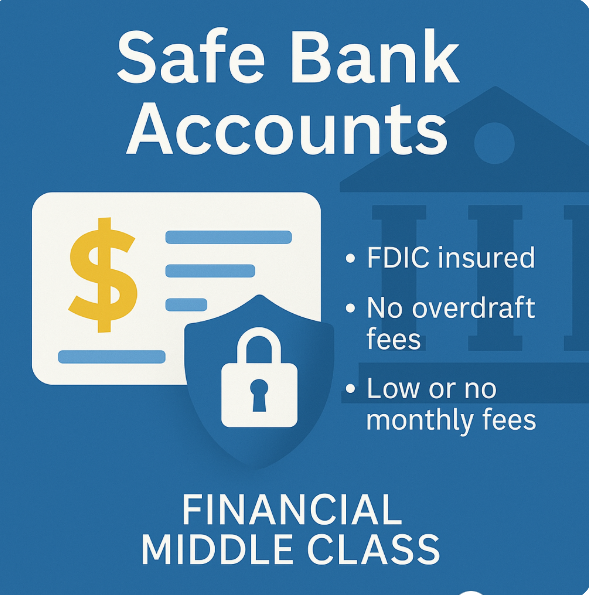A bank account should keep your money safe — not nickel-and-dime you every month.
If you’ve ever been hit with a $35 overdraft fee or had your account closed for being “too low-balance,” you already know: not all bank accounts are safe.
That’s why the Consumer Financial Protection Bureau (CFPB) and the FDIC have been promoting something called Safe Bank Accounts — low-cost, transparent accounts designed to protect you, not punish you.
Let’s break down what they are, why they matter, and how you can get one.
What Is a Safe Bank Account?
A “Safe Bank Account” isn’t just a buzzword — it’s a type of checking or savings account designed to eliminate risky fees and barriers that often trap lower- and middle-income Americans.
Here’s what defines them:
- No overdraft fees. Transactions simply decline if you don’t have enough funds.
- Low or no monthly fees. Most charge $0–$5 a month.
- Low minimum balance requirements. Often as low as $0 or $25.
- Free access to direct deposit and ATM networks.
- FDIC insurance up to $250,000.
These accounts exist under the Bank On initiative — a national partnership led by the Cities for Financial Empowerment Fund that certifies banks offering affordable, consumer-friendly options.
Why Safe Accounts Matter for the Middle Class
You might think safe accounts are only for “unbanked” people, but middle-class households benefit too.
Here’s why:
1. Inflation + Junk Fees = Death by a Thousand Cuts
The average American household pays $250–$400 per year in bank fees — and that’s just for having an account.
When the cost of living is already high, those “maintenance” and “overdraft” fees quietly drain your emergency fund.
2. Financial Security Starts with Predictability
Safe accounts make it easy to track your balance because there’s no overdraft safety net pretending to help while quietly charging you.
You can only spend what’s available — no surprises, no debt spiral.
3. They Help Build Trust in Banking
Roughly 6 million U.S. households remain unbanked because they don’t trust banks. Safe accounts give people a fair entry point — an account that doesn’t punish mistakes.
Related Reads
The CFPB vs. the Banks: What America’s Consumer Watchdog Really Does
Switching Banks Made Simple: A Middle-Class Guide to Beating Junk Fees
From Payday Loans to Junk Fees: Why Predatory Finance Targets the Middle Class
How Other Countries Protect Consumers: What the U.S. Can Learn From Abroad
Where to Find Safe Bank Accounts
You don’t have to hunt far. Many major banks and credit unions now offer Bank On certified accounts.
A few examples:
- Chase Secure Banking℠ – $4.95/month, no overdraft fees.
- Bank of America SafeBalance Banking® – $4.95/month, no overdraft.
- Wells Fargo Clear Access Banking℠ – $5/month, aimed at consumers new to banking.
- Local Credit Unions – Many offer certified accounts with zero monthly fees.
To find one near you, visit bankoncertified.org and type your zip code. You’ll see all certified accounts available in your area.
